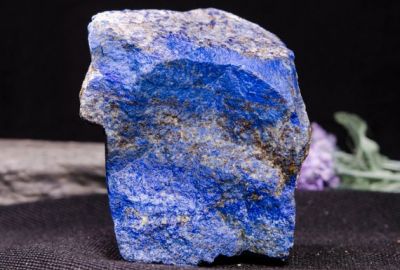Lapis Lazuli

The name comes from the Latin lapis (stone) and the word lazulis, lazar in Farsi (Persian language) which also means stone. It is the root of the Arabic word azraq and the Latin words azzuro azure and azul meaning blue. The main ingredient in lapis lazurite gives the rock its characteristic blue color. It also contains wollastonite, white calcite and small irregular golden iron pyrite crystals, a feature of lapis lazuli. Its hardness on the Mohs scale ranges from 5-5.5, depending on the mining area and quantity.
From antiquity it was a very popular stone, in Mesopotamia, Egypt and the wider Greek area, from there it passed to the Romans more in the form of luxurious utensils and objects for the time. The mines in the Sar-e-Sang Valley, in the Badakhshan Province of northern Afghanistan, are the largest source of sludge. Mining of good quality lapis lazulis, we have in the wider area of Lake Baikal in Russia, and in the Andes in Chile. Small exploitable quantities are found in Pakistan, Italy, Mongolia, USA and Canada. It is one of the first stones mined from underground mines. The first mining sites are 7000 years old. In the Indus River Valley (hindu or Sindhu Valley) in present-day Tibet, Pakistan, Nepal, Northwest India, we find lapid beads in jewellery, but also in decorative motifs in temples and luxury houses.
The Sumerians carved the mud on large surfaces, depicting battles and snapshots of everyday life. The peoples of Mesopotamia transported large volumes of stone to Egypt, where lapis gained great value. In Bibles of the Dead of Egypt, amulets in the shape of an eye with lapis lazuli and gold were found to protect the dead as they passed through the other world. Cleopatra was applying lapis lazuli powder on her eyes, a custom that reached Western Europe until the 18th century.
In India the Sanskrit word "Rajwart'' was the name of the stone. Lapis is widely used in astrology, but also for Ayuverda therapies. It served as an impressive colour in temples for worship purposes and in decoration.
In the 14th century it traveled to Venice and from there to Western Europe, as a colour, by the name "ultramarine".
Ultramarine is one of the main colours of Renaissance painters, Titian, Da Vinci and Michael Angel are among the artists of the time who used it. In the 17th century, the Dutch painter Johannes Vermeer worked with ultramarine the famous painting of "the girl with a pearl earring".
It is the stone of the 5th chakra of the neck (Vishuddha Chakra). The point that unites thought with emotion, speech with expression. Lapis clarifies thoughts and guides emotion.
It is the stone of Wisdom, Art and the Right Word.
Excellent stone for middle age, protects against depression giving calm and strength. Stone of the signs of the Earth, Virgo, Capricorn and Taurus, strengthens creative thinking, but also harmony in with other zodiac signs.

 Ελληνικά
Ελληνικά  English
English